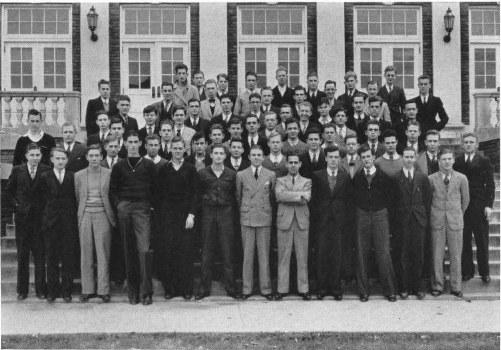Until it was made co-educational in 1964, Woman’s College (now UNCG) was pretty clear in the fact that it was a single-gender institution. Male students were allowed to enroll in summer school courses and graduate programs (at least until the 1950s and 1960s when the UNC system asserted limitations over male enrollment at the school), but they did so in small numbers. Undergraduate education, however, remained reserved for women only – with a single exception.
During the 1932-1933 academic year, President Julius Foust decided to allow young men from the Greensboro area to enroll at WC. Parents and the young men themselves petitioned for admittance, citing dire financial constraints due to the Great Depression. Were they not allowed to attend WC, they might not be able to enroll in college at all that year.
In total 80 men enrolled at WC that year (48 freshman, 21 sophomores, two juniors, and nine others). With the exception of a hygiene course, these co-eds took the same courses as the female students. While they represented only a tiny fraction of the 1,556 students enrolled at the college at the time, these men met resistance upon their arrival. An October 13, 1932 letter to the editor in The Carolinian argued that the men were “so abominably conceited.” They weren’t allowed to wear their own swimsuits for gym classes; instead, they were required to wear the same baggy tank suits used by the women.
The men did adapt to life at the Woman’s College, however. They founded their own Men’s Association, formed for the purpose of “dealing with campus problems and administrative relations peculiar to the men students.” Wyatt Taylor, a former standout basketball player at the University of Texas who was serving at the time as a swimming instructor at the local YMCA, was hired to manage an athletic program for these men.
Part of the athletic program included an intercollegiate basketball team, known as the Tom Cats. Games were scheduled against Elon, High Point, Guilford College, and other nearby institutions. In January 1933, the team scored its first victory, with a 14-11 win over Liberty. The Carolinian noted that the team was “starting off well, and when they get in condition they are due to show the college some real basketball.” A swimming team and a football team were also developed for competition against local schools.
Although the Pine Needles yearbook stated that “it is believed now that co-education will be a permanent fixture on campus,” the experiment with co-education at the WC lasted only a single year. Indeed, president Foust strongly advocated for co-education. In a September 1933 letter to Frank Porter Graham, president of The University of North Carolina system, he wrote, “we can not justify from the standpoint of justice, right and consistency, the admission of girls to the Chapel Hill and Raleigh units without extending the same privilege to boys at the Greensboro unit.” Ultimately, however, the undergraduate population remained reserved for women until the institution officially admitted men to classes in the Fall of 1964.
By Erin Lawrimore

